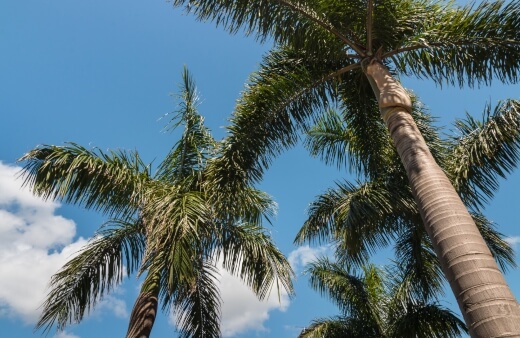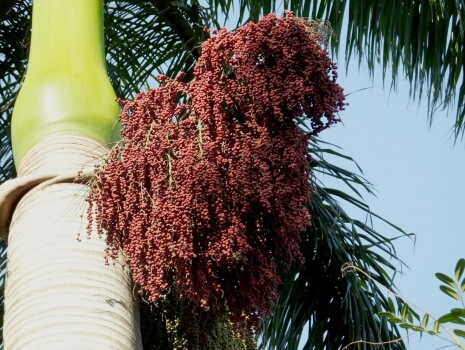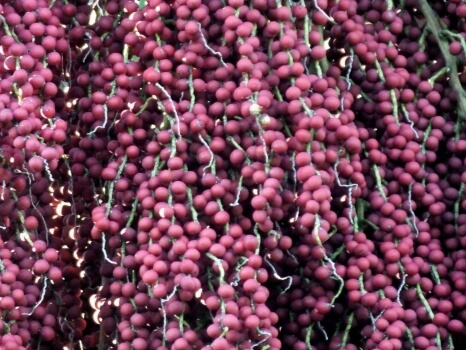When I think about the Alexander palm, I think about a park or a street I might like to drive along to admire the view. I also think about an island holiday, maybe somewhere like Hawaii. I suppose this is the charm of this native tree. You can feel both at home and on holiday, all on the same day.
In our how to grow and care guide, I’ll officially introduce the Alexander palm and some of its characteristics. There is a propagation guide, some tips on how to care for your palm, pests and diseases to look out for, and a few frequently asked questions about this breathtaking Australian native.
More...
Family: | Arecaceae |
|---|---|
Genus: | Archontophoenix |
Species: | A. alexandrae |
Common Names: | Alexander palm, King palm |
Location: | Indoor and Outdoor |
Type: | Tree |
Growth: | Up to 24 metres tall, Up to 4.5 metres wide |
Sun requirements: | Full sun |
Foliage Colour: | Dark green and pale white underneath |
Flower Colour: | Large cream-white |
Flowering: | Spring |
Fruit: | Small, red fruit |
Maintenance level: | Low |
Poisonous for pets: | No |
Introducing the Alexander Palm

Archontophoenix alexandrae is quite a mouthful to pronounce or even remember, so thank goodness this tree is more commonly known as the Alexander palm. It’s also called the King Palm, Northern Bangalow Palm or the Feather Palm.
This charming native plant is actually endemic to Queensland. If you’re wondering where the name came from, it was named to honour Princess Alexandra of Denmark. You will probably have seen this palm all over Australia and it’s indeed very popular.
The Alexander palm is comfortable in suburban gardens and also lining streets and prettying up parks. The palm grows quickly and although tropical is the preferred climate, it has popped up around the world to thrive in colder regions.
The Alexander palm can handle really heavy rainfall and is much loved for its gorgeous shape. As far as palms go, it keeps itself neat.
Archontophoenix aexandrae Plant Features
The average height you’re looking at is around 15 metres but the Alexander palm can grow up to 24 metres tall. With that kind of size, this is not a palm you would often find indoors in a hurry but it can get comfortable on a patio or in a courtyard for example.
This palm has lovely hanging flowers that are white or purple and the clusters of flowers can be up to a metre in length. It kind of looks like a necklace draped on a tree.
The equally good looking leaves are dark green on the top surface and white on the underneath side. The leaves are not flat but have a twisted look. The Alexander palm produces fruit that goes from green to a bright red when it’s ripe.
How to Grow Alexander Palm

Soil
The Alexander palm likes acidic soil and appreciates mulch. Just ensure the mulch doesn’t touch the edges of the tree trunk. The soil should have good drainage too. This hopefully means you won’t be dealing with root rot.
Apparently a happy Alexander palm is one with warm roots and its mulch and manure that achieve this cosy feeling for your palm. Organic matter is like cake to palm trees. You can use something like cow manure or tea tree mulch.
Sunlight
True to the reputation of other palm trees, the Alexander palm will enjoy full sun to part sun to part shade which gives you lots of options for where to place it.
Humidity
The Alexander palm needs some humidity otherwise you might notice that the edge of the leaves become brown. If you need to increase humidity you can place plants closer together, or mist the plant now and then. Placing a small humidifier close by also helps.
Propagating Alexander Palm

Once you decide that the Alexander palm is for you, it’s really easy to propagate your own from seed. The germination process is around 6 weeks. The best time to plant the seeds is during the spring time and the seedlings will need to live somewhere that has full sun or otherwise has part shade.
Plant the seed with just a little bit of soil – you can even half bury it. Palms don’t like to be buried in too much soil or too deep. If you think about how the palm seeds operate in nature this might make more sense.
Alexander palm seeds are carried on the wind and dispersed by animals. This means they are usually just on the surface of the ground where they need to try and grow. The seedling container needs to be somewhere warm and humid.
A bathroom is a good place but make sure it gets enough light. If the bathroom is not an option, you can cover the seedling with a plastic bag and put it on top of the fridge or somewhere warm.
Don’t get a fright if the seeds look a bit shrivelled before sprouting happens. This is normal. When your Alexander palm seedlings have started to sprout, you can move them somewhere even warmer and with high humidity.
By summer time you should be able to move your seedlings outside but make sure the tree has about 4 sets of leaves first. Alexander palm can suffer from root shock when it gets transplanted like some other palm species.
Alexander Palm Care Guide

What Fertiliser to Use
Alexander palm seedlings won’t need any fertiliser initially. You can start feeding them when they’re in the active growing phase. A liquid palm fertiliser is perfect. As a guide, you can feed your palm every 2 weeks during the warm months and stop feeding completely in the winter months.
Watering Schedule
While your Alexander palm is establishing itself, you should aim to keep the soil moist. Once the palm is more mature, you can aim for dry soil in the winter months, and then keep the soil moist in the summer months.
The trick here is that the soil mustn’t become soggy. It’s good to test the soil with your finger to determine how often to water. If it still feels wet, give it some time to dry out a bit more before watering again. Once a week would be our guideline but again, always test the soil first.
Drainage is very important as mentioned with the soil so if your Alexander palm is in a pot, ensure that there is a drainage system to allow for excess water to run off.
Pruning Alexander Palm
Anything that is self-cleaning is worth having in the home. If only this applied to pets and children as well. What you’ve heard about the Alexander palm is indeed true – the palm is self-cleaning, which means more enjoyment without any hard work.
If you notice that the leaves of your Alexander palm are looking dusty, you can wipe them down with a damp cloth. Once a month is enough. This actually helps the leaves to be able to breathe.
The older leaves of the plant start to fade and might become brown as they get older. You can prune off any old bits to enable the plant to give more energy to the newer plant growth.
If you are looking for some honest and in depth reviews about gardening equipment and tools, have a look at our guides. We cover lawn tools, power tools, watering hoses and saws.
Pests and Diseases that Affect Alexander Palm
Scale
One of the common ailments that might affect your Alexander palm is scale. Often when you are dealing with scale, it means that your palm needs extra nutrients. Give it a boost with some mulch and fertiliser.
Scale as a pest actually sucks sap out of the leaves and stems of your palm. It might start to look a bit strange and stunted as the growth is affected. The leaves often turn yellow and get brown marks on them.
You might also see leaves dropping off. You want to remove as much scale from your Alexander palm as possible. Try using a cotton bud dipped in rubbing alcohol to move the pests along.
If you have a small infestation of scale, this treatment using the rubbing alcohol can be quite helpful. You’ll need to inspect your plant carefully as sometimes the scale insects are not always immediately visible like on the underneath of the leaves.
Neem oil is a great organic insecticide that is also very effective for combating scale. It also leaves a kind of protective residue which might help prevent future pests too. A cost effective way to use this treatment is to buy a neem oil concentrate and mix it with some liquid soap and water.
Palm dart butterfly
The palm dart butterfly likes to lay its eggs underneath the palm leaves. The hatched caterpillars like this spot for protection but while they are hanging around, they also end up eating the palm leaves.
They can cause quite a bit of damage and make your Alexander palm look a bit worse for wear. Again, you can use a neem oil application which is a safe and nature friendly way of moving the caterpillars along.
Alexander Palm frequently asked questions

Is the Alexander palm considered an invasive tree?
This palm has earned itself the reputation of a weed in Brisbane particularly. This is because their growth has overtaken the Bangalow palm which is native to that area.
Click here to learn more about the Bangalow palm or Archontophoenix cunninghamiana.
How quickly does an Alexander palm grow?
These palms are considered fast growing. They usually grow about 1 metre per year.
Can you eat the fruit of the Alexander palm?
Yes you could. Aboriginal communities used to cook the fruit for consumption.
For more inspiration on Australian bush tucker and our amazing variety of edible plants, have a browse through our bush tucker categories. We are big on a sustainable lifestyle and share information about how to gather and use native fruits, greens, veggies, herbs and medicinal bush tucker.
For more palm trees to grow in your garden, check out our compilation of growing guides below:
Wrapping Up Our Alexander Palm Growing and Care Guide
A palm tree that can be potted, grown on a patio, or left to achieve its ultimate height, is a remarkable creature indeed. I’m always in awe of the Alexander palm because it has something that spells adventure, while being neat and low maintenance at the same time.
If I could fill my entire garden and home with it, I probably would. To think that from a tiny seed and in just 6 weeks of waiting, you can grow such an extraordinary specimen of a tree.
They grow quickly and certainly manage to creep into your heart with their beauty and stature. I would certainly give the Alexander palm my green thumbs up.
Published on October 14, 2022 by Nathan Schwartz
Last Updated on February 22, 2024




